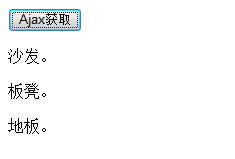jQuery Ajax load() method_jquery
load()方法是jQuery中最为简单和常用的Ajax方法,能载入远程HTML代码并插入到DOM中。它的语法结构为:
load( url [, data][, callback] )
load()方法参数解释见下表:
| 参数名称 | 类 型 | 说 明 |
| url | String | 请求HTML页面的URL地址 |
| data(可选) | Object | 发送至服务器的key/value数据 |
| callback(可选) | Function | 请求完成时的回调函数,无论请求成功或失败 |
1. Load HTML document
First create an HTML file named test.html to prepare for background Ajax loading. The code is as follows:
Zhang San:
Sofa.
Wang Wu:
Floor.
Then create a new blank page and add two elements on it : The
< ;/html>
When the button is clicked, the following interface appears:
Obviously, the load() method has completed the originally tedious work. Developers only need to specify the target location for the HTML fragment using jQuery selectors and then pass the URL of the file to be loaded as a parameter to the load() method. 
2. Filter the loaded HTML documents
The previous example is to load the contents of the test.html page into the element with the id "resText". If you only need to load certain elements within the test.html page, you can use the URL parameters of the load() method to achieve your goal. By specifying selectors for URL parameters, you can easily filter out the required content from the loaded HTML document. The syntax structure of the URL parameter of the load() method is: "url selector". Note that there is a space between the URL and the selector.
For example, you only need to load the content with class "para" in the test.html page. You can use the following code to complete:
$("#resText").load("test.html .para");
The running effect is as follows:  3. Transfer method
3. Transfer method
The transfer method of the load() method is automatically specified according to the parameter data. If no parameters are passed, it will be passed in GET mode; otherwise, it will be automatically converted to POST mode.
//If no parameters are passed, it is GET method
$("#resText").load("test.php",function(){
//......
});
//If there are parameters to pass, it is POST method
$("#resText").load("test.php",{name:"xht555",age:"24" }, function(){
//...
});
4. Callback parameters
For operations that must be completed before loading can continue, The load() method provides a callback function (callback), which has three parameters, representing the content returned by the request, the request status and the XMLHttpRequest object. The jQuery code is as follows:
$("#resText").load("test.html",function(responseText,textStatus,XMLHttpRequest){
//responseText: Content returned by the request
//textStatus: Request status: 4 types: success, error, notmodified, timeout
//XMLHttpRequest: XMLHttpRequest object
});
Note: In the load() method, no matter whether the Ajax request is successful or not, the callback function (callback) will be triggered as long as the request is completed.

Hot AI Tools

Undresser.AI Undress
AI-powered app for creating realistic nude photos

AI Clothes Remover
Online AI tool for removing clothes from photos.

Undress AI Tool
Undress images for free

Clothoff.io
AI clothes remover

AI Hentai Generator
Generate AI Hentai for free.

Hot Article

Hot Tools

Notepad++7.3.1
Easy-to-use and free code editor

SublimeText3 Chinese version
Chinese version, very easy to use

Zend Studio 13.0.1
Powerful PHP integrated development environment

Dreamweaver CS6
Visual web development tools

SublimeText3 Mac version
God-level code editing software (SublimeText3)

Hot Topics
 1386
1386
 52
52
 How to use PUT request method in jQuery?
Feb 28, 2024 pm 03:12 PM
How to use PUT request method in jQuery?
Feb 28, 2024 pm 03:12 PM
How to use PUT request method in jQuery? In jQuery, the method of sending a PUT request is similar to sending other types of requests, but you need to pay attention to some details and parameter settings. PUT requests are typically used to update resources, such as updating data in a database or updating files on the server. The following is a specific code example using the PUT request method in jQuery. First, make sure you include the jQuery library file, then you can send a PUT request via: $.ajax({u
 PHP and Ajax: Building an autocomplete suggestion engine
Jun 02, 2024 pm 08:39 PM
PHP and Ajax: Building an autocomplete suggestion engine
Jun 02, 2024 pm 08:39 PM
Build an autocomplete suggestion engine using PHP and Ajax: Server-side script: handles Ajax requests and returns suggestions (autocomplete.php). Client script: Send Ajax request and display suggestions (autocomplete.js). Practical case: Include script in HTML page and specify search-input element identifier.
 How to get variables from PHP method using Ajax?
Mar 09, 2024 pm 05:36 PM
How to get variables from PHP method using Ajax?
Mar 09, 2024 pm 05:36 PM
Using Ajax to obtain variables from PHP methods is a common scenario in web development. Through Ajax, the page can be dynamically obtained without refreshing the data. In this article, we will introduce how to use Ajax to get variables from PHP methods, and provide specific code examples. First, we need to write a PHP file to handle the Ajax request and return the required variables. Here is sample code for a simple PHP file getData.php:
 jQuery Tips: Quickly modify the text of all a tags on the page
Feb 28, 2024 pm 09:06 PM
jQuery Tips: Quickly modify the text of all a tags on the page
Feb 28, 2024 pm 09:06 PM
Title: jQuery Tips: Quickly modify the text of all a tags on the page In web development, we often need to modify and operate elements on the page. When using jQuery, sometimes you need to modify the text content of all a tags in the page at once, which can save time and energy. The following will introduce how to use jQuery to quickly modify the text of all a tags on the page, and give specific code examples. First, we need to introduce the jQuery library file and ensure that the following code is introduced into the page: <
 Use jQuery to modify the text content of all a tags
Feb 28, 2024 pm 05:42 PM
Use jQuery to modify the text content of all a tags
Feb 28, 2024 pm 05:42 PM
Title: Use jQuery to modify the text content of all a tags. jQuery is a popular JavaScript library that is widely used to handle DOM operations. In web development, we often encounter the need to modify the text content of the link tag (a tag) on the page. This article will explain how to use jQuery to achieve this goal, and provide specific code examples. First, we need to introduce the jQuery library into the page. Add the following code in the HTML file:
 PHP vs. Ajax: Solutions for creating dynamically loaded content
Jun 06, 2024 pm 01:12 PM
PHP vs. Ajax: Solutions for creating dynamically loaded content
Jun 06, 2024 pm 01:12 PM
Ajax (Asynchronous JavaScript and XML) allows adding dynamic content without reloading the page. Using PHP and Ajax, you can dynamically load a product list: HTML creates a page with a container element, and the Ajax request adds the data to that element after loading it. JavaScript uses Ajax to send a request to the server through XMLHttpRequest to obtain product data in JSON format from the server. PHP uses MySQL to query product data from the database and encode it into JSON format. JavaScript parses the JSON data and displays it in the page container. Clicking the button triggers an Ajax request to load the product list.
 How to tell if a jQuery element has a specific attribute?
Feb 29, 2024 am 09:03 AM
How to tell if a jQuery element has a specific attribute?
Feb 29, 2024 am 09:03 AM
How to tell if a jQuery element has a specific attribute? When using jQuery to operate DOM elements, you often encounter situations where you need to determine whether an element has a specific attribute. In this case, we can easily implement this function with the help of the methods provided by jQuery. The following will introduce two commonly used methods to determine whether a jQuery element has specific attributes, and attach specific code examples. Method 1: Use the attr() method and typeof operator // to determine whether the element has a specific attribute
 Understand the role and application scenarios of eq in jQuery
Feb 28, 2024 pm 01:15 PM
Understand the role and application scenarios of eq in jQuery
Feb 28, 2024 pm 01:15 PM
jQuery is a popular JavaScript library that is widely used to handle DOM manipulation and event handling in web pages. In jQuery, the eq() method is used to select elements at a specified index position. The specific usage and application scenarios are as follows. In jQuery, the eq() method selects the element at a specified index position. Index positions start counting from 0, i.e. the index of the first element is 0, the index of the second element is 1, and so on. The syntax of the eq() method is as follows: $("s





There are comments: